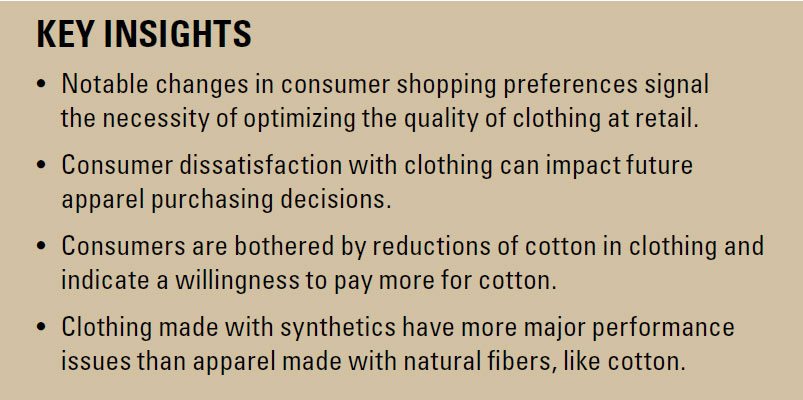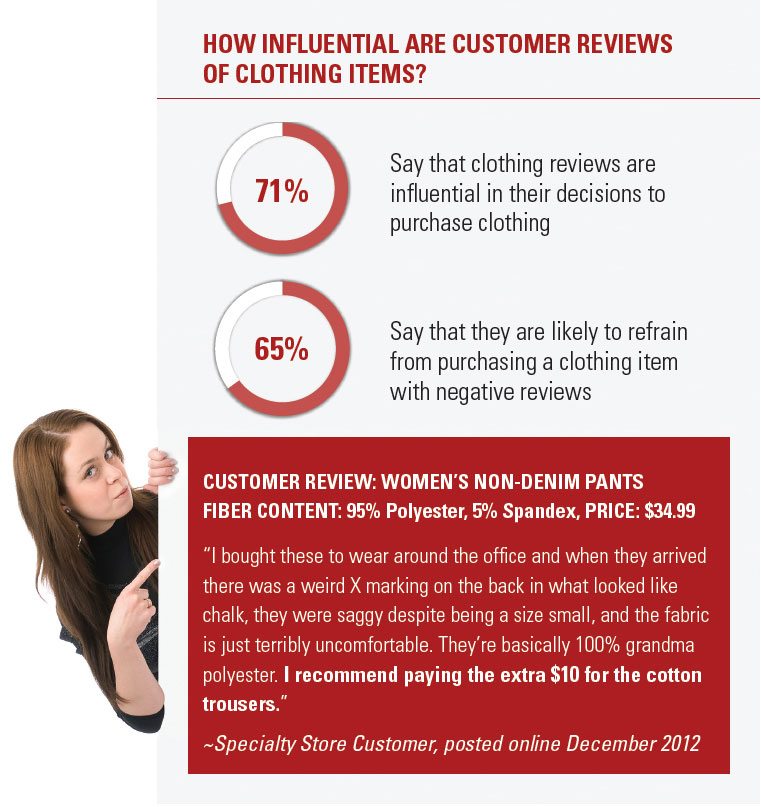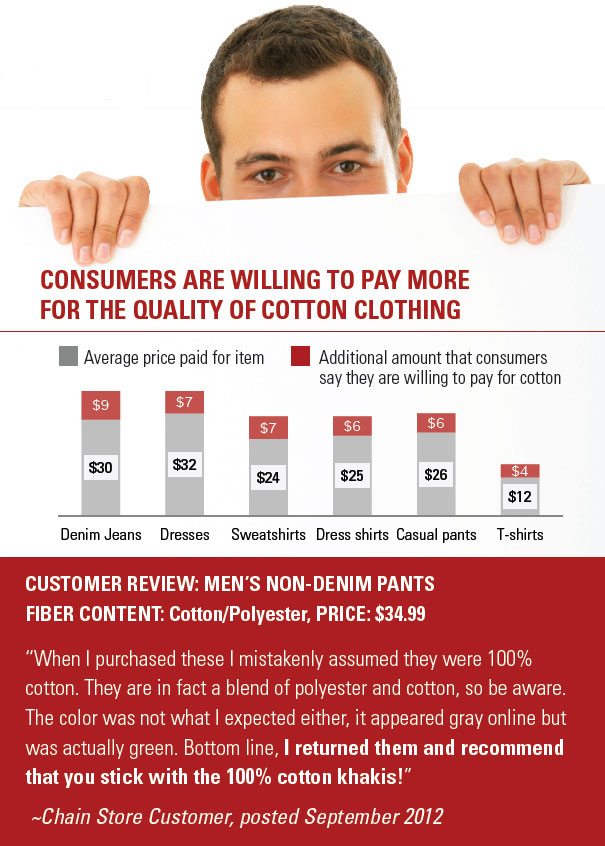Retailers and brands have unprecedented access to direct feedback about the experiences customers have with  their apparel purchases. Research reveals that unfavorable consumer opinions about clothing purchases could be detrimental to the reputations of retailers and brands and that customer satisfaction has been negatively impacted by textile changes in clothing. Consumers report that apparel fabrics are thinner (63%), clothing does not last as long as it once did (59%), and clothing typically made with cotton is now made with other fibers (55%). In an increasingly transparent market environment, such negative customer experiences could make sustaining competitiveness more difficult for the global apparel industry.
their apparel purchases. Research reveals that unfavorable consumer opinions about clothing purchases could be detrimental to the reputations of retailers and brands and that customer satisfaction has been negatively impacted by textile changes in clothing. Consumers report that apparel fabrics are thinner (63%), clothing does not last as long as it once did (59%), and clothing typically made with cotton is now made with other fibers (55%). In an increasingly transparent market environment, such negative customer experiences could make sustaining competitiveness more difficult for the global apparel industry.
Studying customer reviews of clothing is a convenient method to discover clues about what clothing will remain on store racks and what clothing shoppers will purchase. While developing an understanding of customer needs and preferences is possible by reading customer reviews, a more robust analysis of this type of consumer feedback tends to expose key trends that could remain undetected. Cotton Incorporated’s Customer Comments Research™, an analysis of more than 260,000 reviews of over 30,000 apparel and home textiles products, provides leading market intelligence to help manufacturers and retailers prevent consumer dissatisfaction and maximize customer loyalty.
racks and what clothing shoppers will purchase. While developing an understanding of customer needs and preferences is possible by reading customer reviews, a more robust analysis of this type of consumer feedback tends to expose key trends that could remain undetected. Cotton Incorporated’s Customer Comments Research™, an analysis of more than 260,000 reviews of over 30,000 apparel and home textiles products, provides leading market intelligence to help manufacturers and retailers prevent consumer dissatisfaction and maximize customer loyalty.
CLOTHING CUTBACKS
Over the past decade, consumer shopping preferences have shifted. Consumer interest in clothes shopping declined to 30% in 2013 (down from 38% in 2003), while preferences for shopping for items such as electronics and food increased. Declining interest in clothes shopping may be connected to reports from more than 2 out of 3 consumers (72%) that clothing prices have increased, at the same time that 52% say that the overall quality of apparel offerings has declined. Customers have noticed the results of various cost-cutting measures to preserve retail margins that the apparel industry has implemented, including changes in fabric weights and finishes, elimination of construction elements such as pockets and detailing, and the substitution of other fibers for cotton. More than half of U.S. consumers (53%) say they are bothered by declines of cotton content in their apparel purchases.
Because customer satisfaction can affect retail sales, acquiring consumer feedback is essential. Direct feedback in the form of customer reviews can be used to help resolve issues and reveal ways to boost consumer preferences for buying apparel. Reviews can also influence other customers. More than 8 out of 10 consumers state they would likely not buy a piece of apparel if multiple reviews say the item fell apart within a few wearings, and more than 7 out of 10 report that they would not purchase clothing if reviews claimed an item held odor, pilled, or shrank after laundering.
CONSUMER ISSUES WITH APPAREL
Analysis of customer reviews collected from clothing sold by 25 major retailers, and that included 2400 different brands, revealed that size and fit problems are the most reported customer issues, with shrinking, wrinkling, pilling, fading, stretching, snagging, itching, and odor as the top textile performance concerns. Although problems like shrinking and fading can affect garments of all fiber types, customer reviews indicate that synthetic clothing tends to have more major performance issues than apparel made with natural fibers like cotton. For example, some synthetic clothing has a higher likelihood to have odor and snagging issues. Other problems experienced with 1 00% synthetic clothing include pilling, itching, and wear and tear.
00% synthetic clothing include pilling, itching, and wear and tear.
Consumers have experience with managing the issues most cited in customer reviews about cotton clothing. Shoppers can buy pre-shrunk cotton apparel and can make certain laundering choices (e.g., cold water washing) to address issues such as shrinking and fading. The fact that more than 8 out of 10 consumers prefer cotton-rich apparel and that 50% say they are willing to pay higher prices to keep cotton in their clothing validates cotton’s ability to meet consumers’ quality expectations. Shoppers indicate a willingness to pay 20% to 30% more to keep cotton in their clothing. Although reductions in cotton content may have provided short-term cost-savings, long-term challenges such as potential customer loss, decreased profits, and harm to a retailer or brand’s image could occur.
RESTORING CUSTOMER SATISFACTION
Strengthening quality control practices in textiles processing and manufacturing can prevent many of the problems that customers have experienced with clothing at retail. Using customer feedback to identify clothing issues that cause dissatisfaction could also help improve quality control practices and bolster sales. Consulting technical specialists at Cotton Incorporated can provide knowledge and expertise in solving or minimizing issues related to cotton clothing to help maximize customer satisfaction and retention. For more insight and recommendations based on consumer feedback on U.S. apparel products.
About the Research
Cotton Incorporated Lifestyle Monitor™ survey is a monthly online research study that gauges the attitudes and behaviors of U.S. consumers regarding clothing, appearance, fashion, home furnishings, fiber selection, and other topics.
Cotton Incorporated’s Customer Comments Research™ includes analysis of over 260,000 customer reviews, posted from 2010 to 2013, on over 30,000 U.S. apparel and home textiles products.
